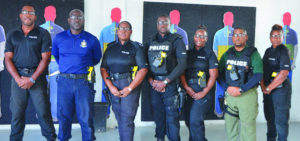
A group of four officers from the UK have been recently on the island conducting a training programme to educate, in the first instance, six officers of the Royal Anguilla Police Force (RAPF) in “Taser” usage.
On Wednesday, January 10th, a press conference was held by Commissioner of Police, Mr. Robert Clark, to introduce the two high level officials who are overseeing the training programme. They are Chief Constable, Lucy D’orsi and retired Police Sergeant, Andy Harding, both of the British Transport Police in London.
Commissioner Clark specifically introduced Constable Lucy D’orsi as the UK’s National Police Chief Constable Lead for less lethal options. “I am in charge of British Transport Police, which is the Police Force that covers England, Scotland and Whales,” she said. “I am here because I am the National Police Chief Council, and I am, in effect, I am the custodian for Tasers in the UK.”
Mr. Harding introduced himself as the National Police Chief Council’s Strategic Manager for Less Lethal Weapons. “I am a former Police Inspector, and currently work with Chief Constable Lucy D’orsi as her Advisor for weapons, which include Tasers,” he said.
In highlighting the reason why it is essential for officers to be trained in Taser deployment, Commissioner Clark explained that the use of Tasers by police officers would present a less lethal means of subduing a culprit who presents a threat than the use of a fire arm. He noted that here in Anguilla there have been two known cases where the aggressor was unfortunately shot by police. “Had a Taser been used instead of the officers’ firearm,” he said, “then the outcome would not have been detrimental.”
“As a Commissioner of Police,” he said, “I think that it is really important that the RAPF have access to this less lethal devise. Lucy and Andy will give us information on what the Taser is, and more importantly what it isn’t.”
“They will speak about the level of training that the RAPF is receiving from the four UK trainers who are running the training programme,” he said. “These trainers will be on the island for the purpose of training trainers in Taser use over the next few weeks, so that when the time is right we would be able to train our own staff.”
“As the Commissioner of Police, through the Office of the Governor, through the Premier and the Government of Anguilla,” Mr. Clark said, “it is my mandate to ensure the safety of the community and the officers who work for me on this island.”
“Most people would already know that we carry a number of items to subdue aggressors,” he said. “These include firearms, batons, incapacitating spray and handcuffs. However, there is a gap that needs to be filled.”
“There needs to be another option available to our officers for effectively subduing aggressive offenders on scenes of trouble,” the Commissioner observed. “This option, the Taser, would give us a bridge between the use of a baton, an incapacitating spray and the use of a fire arm.”
“Persons in Anguilla would be aware that unfortunately in the past police have had to use lethal force in extreme circumstances,” he said. “I believe that the introduction of this particular device, the Taser, will help to prevent such circumstances as we move forward.”
After presenting a series of slides which introduced the Taser X2, the Commissioner outlined the legal parameters under which the device would implemented in relation to the Criminal Code, and the policies which provide for the usage of the Taser X2 by RAPF officers.
Constable Lucy D’orsi explained that the Taser is a safe device that only incapacitates the aggressor. She stressed, “I would like to assure the Anguillian community that the Taser is rigorously tested to ensure its safety. Besides we take into consideration the medical implications of the use of a Taser to verify that each device is safe to use by trained officers.”
A thorough display of the Taser X2, which is made by Axon Enterprises Inc, was presented by Officer Harding. He highlighted the four steps by which an officer should be guided before making a calculated decision to actually fire off the Taser. These steps are: 1. Drawing the weapon; 2. Aiming the weapon; 3. Arcing the weapon; and 4. Red-dotting the weapon. This fourth step marks the suspect with a red dot and indicates to the suspect that he or she is being “warned”. If the suspect is red-dotted and is still behaving aggressively, only then should the officer make a calculated decision to actually fire off the probe in order to subdue the aggressor and deescalate the situation.
After Officer Harding’s presentation, media personnel were taken on a guided tour at the police training barracks to witness the actual use of the Taser X2.
Commissioner Clark insisted that the proposed used of the Taser as a less lethal method of subduing an aggressor is in no way linked to the recent rise of crime on the island. He said that, in fact, plans for implementing the use of the Taser have been initiated since some four years ago.
“The time is now right,” he said, “for trained police officers of the RAPF to deploy this weapon for their safety and the safety of any extremely aggressive offender who may pose the risk of a threat.”








